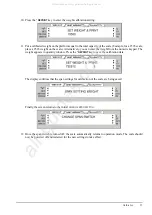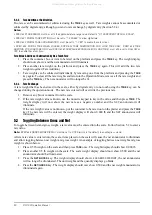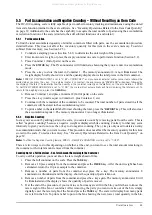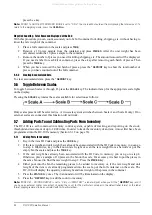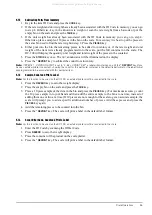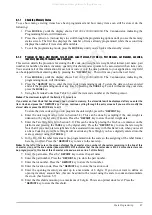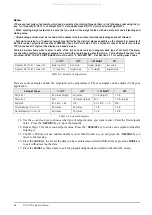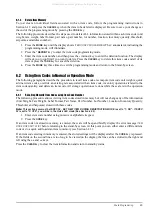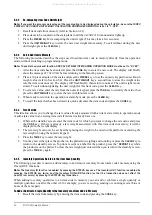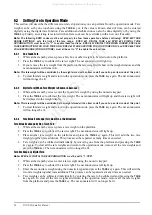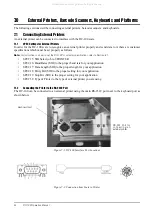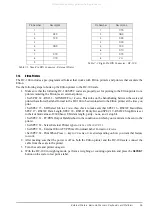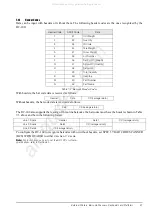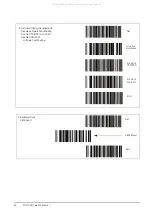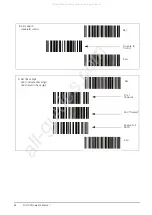
Scale Programming
37
6.1.1
Checking Memory Status
To see how many existing items have been programmed and how many items can still be stored, do the
following:
1. Press
MODE
key until the display shows
ITEM CODE PROGRAMMING
. The
S
annunciator, indicating the
Programming Mode, will illuminate
2. Press the
+
(plus) or
–
(minus) keys to scroll through the programming options until you see the memory
status screen. The first line displays the number of items already programmed while the second line
displays the number if item slots still available.
3. To exit the programming mode, press the
MODE
key until you are back at the stand-by screen.
6.1.2
Program ID Code, Unit Weight, Tare Weight, Label Format, Part Name, Part Number, Lot Number, Location,
Inventory Quantity, Threshold, and Setpoints
This section details the procedure for storing the ID code, unit weight, tare weight, label format, part name, part
number, lot number, location, inventory quantity, threshold, and set points to be associated with an item code.
You can enter all of this information for each item code or only the data pertinent to your application. Any field
can be skipped without entering data by pressing the
* REPRINT
key. This will move you to the next field.
1. Press
MODE
key until the display shows
ITEM CODE PROGRAMMING
. The
S
annunciator, indicating the
programming mode, will illuminate.
2. Press the
* REPRINT
key to enter the item code programming mode. To store the data you have entered
and exit the programming mode at any time by pressing the
CODE
key. To exit without saving your data,
press the
MODE
key.
3. Using the Teraoka Codes from Table 6-1,enter the item code number at the flashing cursor.
Notes:
The maximum length of the field is 32 characters.
If you enter an Item Code that has already been stored in memory, the stored data will be displayed after you enter the
Item Code and press the
* REPRINT
key. You can continue cycling through the entry screens if you want to modify the
stored data or press the
MODE
key to exit.
To store the item code and go on to program the unit weight, press the
* REPRINT
key.
4. Enter the unit weight value (refer to Section 5.4). This can be done by sampling if the unit weight is
unknown or by digital entry if known. Press the
* REPRINT
key to store the unit weight data.
5. Enter the Tare Weight (refer to Section 5.2). This can be done by placing the bin, box or container on the
platform and pressing the
TARE
key or by digital entry. Press the
* REPRINT
key to store the tare weight.
Note that if you enter a tare weight here to be associated in memory with this Item Code, when you recall
an Item Code this stored Tare Weight will override any Tare Weight you have digitally entered into the
scale or entered using the
TARE
key.
6. In the DC-100 the label formats are pre-programmed into the scale so the assigning of the label format
here has no effect. Press the
* REPRINT
key to move to the next step.
Note:
To the left of the cursor, the screen displays the character size, number of characters remaining in the line at this
character size, and the line number [Example: M3/32/01 indicates that the character size is M3, 32 more characters can
be programmed on this line at this character size and we are on line 1 of this field.].
7. Enter the part name. Press the
* REPRINT
key to store the part name.
8. Enter the part number. Press the
* REPRINT
key to store the part number.
9. Enter the lot number. Press the
* REPRINT
key to store the lot number.
10. Enter the location code. Press the
* REPRINT
key to store the location code.
11. Enter the opening inventory amount up to a maximum of 8 digits. If you do not want to define an
opening inventory amount here, this can be added to the record using the scale to count and accumulate
the stock. (See Section 5.7)
12. Enter the threshold amount up to a maximum of 8 digits. This is an optimal stock level. Press the
* REPRINT
key to store the threshold.
All manuals and user guides at all-guides.com
all-guides.com





